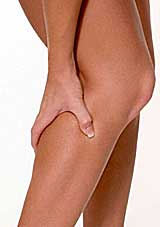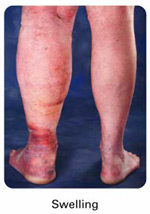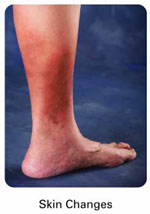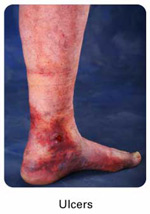On this page you will learn about the signs and symptoms of venous insufficiency, also known as venous reflux, its various manifestations, as well as some of the long-term implications for your health.
Bear in mind, an accurate diagnosis of venous insufficiency can only be made by a qualified vein specialist.
A vein specialist can also recommend the most effective treatment options. Because every patient’s situation is unique, what may be the best treatment for some patients may not necessarily be the best for you.
Patient Demographics
Ten times more patients suffer from venous insufficiency than peripheral arterial disease in the United States. Although often mistaken as a cosmetic problem, venous insufficiency can produce significant clinical problems for the patient.

Venous insufficiency can significantly impact a person’s lifestyles, especially when the person has a profession which requires standing . Market research indicates that over 2 million workdays are lost annually in the US and $1.4 billion is spent each year on this common medical condition.
Of the 25 million Americans with venous insufficiency, approximately 7 million exhibit serious symptoms such as edema, skin changes and venous ulcers. It is estimated that in America, 72 percent of women and 42 percent of men will experience varicose veins by the time they are in their 60s. Prevalence is highly correlated to age and gender.1
Venous System Anatomy
The veins in the lower limbs are classified into two systems:
- Superficial Veins (including saphenous).
- Deep Veins.
The two systems are connected by perforating veins that pass through the deep fascia at mid-thigh, knee and ankle. The diagram shows the veins of the superficial system in blue and pink and the deep system in gray. The great saphenous vein is highlighted in pink.
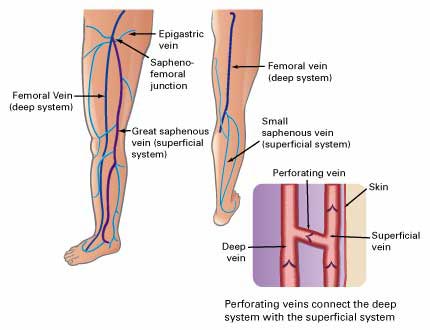
Three factors influence the return of blood back to the heart:
- Respiration: The movement of the diaphragm creates a negative pressure that assists the return of blood from the legs to the heart.
- Vein Valves: Healthy valves close, preventing blood from refluxing or pooling.
- Calf Muscle Pump: Action of the calf muscle helps to force blood upward.
Venous Insufficiency
Venous insufficiency, also know as venous reflux, is the impaired return of venous blood from the legs and feet, often manifesting as varicose veins, swollen ankles, aching legs, skin changes or venous ulcers.
In many cases, venous insufficiency is the result of over-dilation of the venous vessels in the legs. This dilation eventually prevents the valve cusps from closing properly resulting in reflux. The pooling of blood results in ineffective flow back to the heart.
In some cases the reflux is caused not only by the over dilation of the vessel wall, but also by damaged or absent valves.
One of the most common clinical manifestations of venous insufficiency is varicose veins (see more below). Varicose veins are superficial veins that have dilated in response to increased pressure due to incompetent valves. These varicose veins progressively worsen, and often manifest into other symptoms, if left untreated.
Patients presenting with varicose veins should be referred to a surgeon or vein specialist to undergo a physical examination and/or in-depth evaluation, including a duplex ultrasound study.
Common Symptoms Of Venous Insufficiency
In the absence of other symptoms, patients with cosmetic concerns due to the presence of varicose veins might be evaluated with only a physical examination.
However, patients presenting with other symptoms of venous insufficiency, such as those listed below, should also undergo an in-depth evaluation, including a duplex ultrasound study.
- Leg pain, aching, tired or weak legs, especially after long periods of standing or sitting.
- Varicose veins.
- Burning or itching of the skin.
- Swollen legs and/or swollen ankles (edema).
- Open wounds (skin ulcers).
Varicose Veins
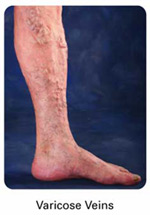
Varicose veins are typically found in the superficial venous system and often involve the main trunk veins – the great and small saphenous veins – as well as tributaries.
Varicose veins are superficial veins that have expanded in response to increased pressure caused by incompetent or absent valves. This dilation eventually prevents the valve cusps from closing properly resulting in reflux. Alternatively, a lack of competent valves can also cause dilation of the vein. As one valve fails, increasing pressure is exerted on each more distal valve until they, too, become incompetent. Diameters of varicose veins can range from 3 mm to > 8 mm.2
The disease is typically progressive and if left untreated can encompass the entire vessel and can ultimately affect the deep system. Learn more about varicose veins…
Edema and Leg or Ankle Swelling With and Without Skin Changes
Edema and swollen ankles are the next progressive states of venous insufficiency and occur as the result of venous hypertension forcing fluid into the lymphatic and interstitial spaces.
This can cause leg or ankle swelling and changes in skin pigmentation. Severe pain and discomfort are typical of these conditions, particularly in the lower leg (calf and ankle) where proximity of nerves exacerbates the situation. In addition to superficial involvement, these stages usually include some portion of the deep vein system (including perforators).
Active and Healed Venous Ulcers
Venous ulcers indicate the most severe forms of venous insufficiency and typically involve both the deep (including perforators) and superficial vein systems. Extreme reflux and venous hypertension result in changes in the microcirculation of the skin eventually leading to severe ulceration.
Anatomic involvement at these stages generally involves the saphenous system3, the perforators (typically the Cockett perforators), and the deep system (typically the femoral, superficial femoral and/or the profunda). A smaller subset of the population has deep system-only involvement (<5 percent) and an even smaller portion perforator-only incompetence.
- Barron HC, Ross BA. Varicose Veins: A guide to prevention and treatment. NY, NY: Facts on File, Inc. (An Infobase Holdings Company); 1995;vii.
- Goldman M. Sclerotherapy: Treatment of Varicose and Telangiectatic Leg Veins. 2nd ed. Mosby; 1995. p. 250-251, 431-465.
- Labropoulos N. The role of the distribution and anatomic extent of reflux in the development of signs and symptoms in chronic venous insufficiency, J Vasc Surg 1996; 23:3:504-510.






